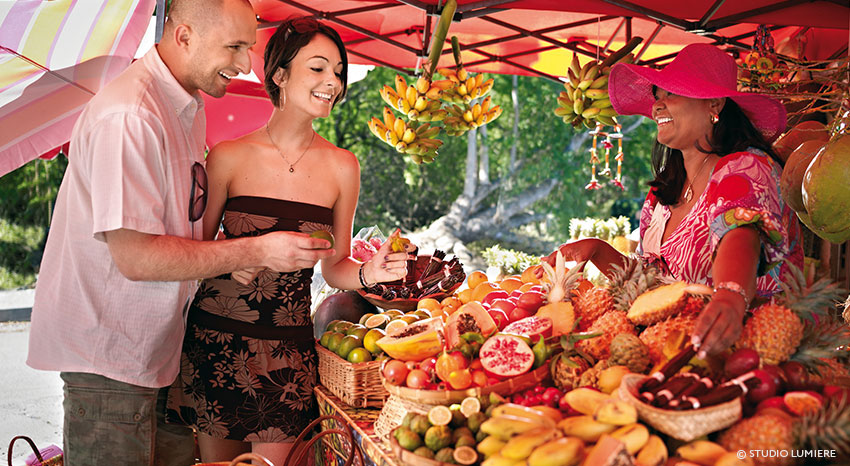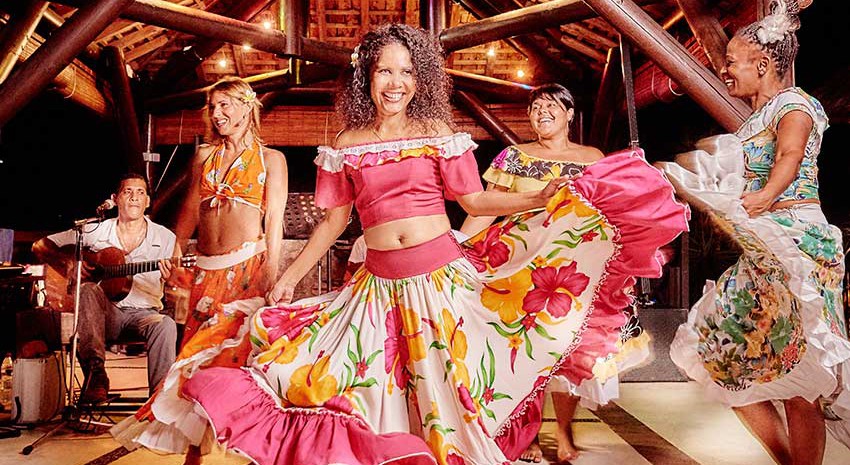What is there to do and see in Reunion? Here’s a selection of the best tourist sites you mustn’t miss during your stay: walks, museums, heritage visits and many more.

The island’s west coast is one of great diversity. Stretching from Saint-Louis to La Possession, it is also called the leeward coast. The climate is dry and sunny, with beaches, lagoons and the open sea.
Getting around is made easier by the Route des Tamarins, a dual carriageway running across the west coast at mid-altitude, with impressive and artistic bridges crossing ravines and boasting stunning views across the Indian Ocean. Up in the hills, the land is covered with primary forests or replanted cryptomeria trees.
Saint-Paul, home to Reunion’s first settlement
One of the largest municipalities in France. Featuring the island’s widest bay, Saint-Paul also includes the resort of Saint-Gilles and the part of Mafate which lies on the left of the Rivière des Galets (Marla, Roche-Plate, Ilet-des-Orangers).
Things to see and do in and around Saint-Paul:
– The viewpoint looking over the cirque of Mafate from Le Maïdo
– The Marine Cemetery, evoking the memories of some of Reunion’s most famous inhabitants, such as Leconte de Lisle
– The market along the seafront every Friday
– The beaches of Boucan, Roches-Noires, Ermitage, La Saline and Trou d’eau.
– The village of Villèle up in Saint-Gilles-les-Hauts, including the Villele Museum, the neo gothic Chapelle Pointue (built in 1845) and ‘La Misère’, a chapel built in the 80s and repainted with the typically bright colours of Reunion’s Tamil temples. In addition to the weekly services, there are three major religious festivals celebrated every year, dedicated to the goddesses Marliemin, Pandiali (fire-walking) and Karli.
– Hiking in the cirque of Mafate
– The village of Petite France with its geranium distilleries and mountain-biking trails up the road to Le Maïdo
– The Bassin Bleu Golf Course
– The Aquarium in Saint-Gilles
– The Jardin d’Eden.
Saint-Leu, something for everything!
This small town between the West and the South of the island boasts a lot of attractions to charm many a visitor. First of all, its picturesque, quiet and colourful town centre is a wonderful place for a stroll, from Notre Dame de la Salette down to the small marina. The beach stretches from one end of the town to the other. And after the sea, why not take to the air?! Saint-Leu is well-known for the many paragliders you can see in the sky at all times of the day, and the Paragliding World Championships are organized here every year.
Things to see and do in and around Saint-Leu:
– The former salt factory at La Pointe au Sel
– The Mascarin National Botanic Conservatory
– Kélonia (marine turtle sanctuary)
– The market along the seafront next to the town hall, every Saturday from 6am to 1pm.
– Leisure activities: sailing, scuba-diving, fishing, paragliding, mountain-biking, trekking, visiting forest trails
– The remnants of important historic buildings (e.g. Town Hall)
– The Stella Matutina Museum, a former sugar factory
– Le souffleur, a natural blow-hole by the coast
Due to its lush green nature, the south of the island is also called the Wild South, close to the ‘Pitons Cirques and Remparts’, Reunion’s natural wonders classified as World Heritage by UNESCO. The wild south covers the south-eastern part of Reunion between Saint-Benoît and Saint-Joseph, featuring beaches, steep cliffs, forests, picturesque villages and fishing ports, with Piton de la Fournaise looming overhead, one of the most active volcanoes in the world.
Things to see and do in the Wild South:
– The volcano, Piton de la Fournaise
– Manapany-Les-Bains and its natural swimming pool
– The beach and natural swimming pool at Grande Anse
– Langevin and its spectacular waterfalls and pools.
– Lava flows at the Grand Brûlé
– Lava tunnels
– L’Anse des Cascades
– Cap Méchant
– Puits des anglais
– Garden of Perfumes and Spices
– Viewpoint in Les Makes
Reunion Island could be described as a Garden of Eden with a hidden fire at its core. At 2632 m, the summit of Piton de la Fournaise is one of the most active volcanoes in the world. Every year, the volcano shows off with colourful displays turning the night sky a shade of orangey-red. Its flanks are an adventure playground for hiking enthusiasts, with footpaths winding amongst the craters.
Because of frequent showers, the east coast of the island is often overlooked by tourists, but with its very lush vegetation and little villages, it represents a different facet of our island, one that has been the least affected by modernity. There are many spectacular pools and waterfalls. When people arrived from India, they flocked to this area to benefit from the fertile land, and much of the Tamil population still lives here today – why not visit the different temples?
It is also in this region of the island that the method for the fertilization of vanilla was discovered, and is still used today all over the world.
Things to see and do in the east:
– Niagara waterfall
– The kids’ playground in Bocage
– The Sainte-Suzanne Lighthouse
– Le Domaine du Grand Hazier and La Vanilleraie, where you can learn all about vanilla
– Bassin Bœuf
The north of the island and its main town, Saint-Denis, boasts all the attractions for those looking for a cultural visit in Reunion. With its many museums and sites to see, Saint-Denis will appeal to those who love history and would like to learn more about Reunionese culture.
Things to see and do in the north:
Saint-Denis:
– Creole houses and buildings of the East India Company, particularly Villa Déramond-Barre and the Prefecture, open to the general public on the occasion of special European Heritage Days
– Léon Dierx Museum, Artothèque, Art Galleries
– Natural History Museum and State Garden
– Grand Marché (Indian Ocean handicrafts) and Petit Marché (fruit, vegetables, spices)
– Mosque and other religious buildings
– Theatres and shows at the Grand Marché Theatre, Champ Fleuri Theatre, La Fabrik
– Walks along the seafront at Le Barachois
– the picnic area in Le Brûlé, and the beginning of walks (Cascade Maniquet) or hikes (La Roche Ecrite)
– La Montagne, with its adventure playgrounds, the Colorado Golf Course and Le Jardin de Cendrillon
Cilaos: the perfect place for outdoor sports
It is located in the heart of Reunion Island, on the southern side of Piton des Neiges, an extinct volcano culminating at an altitude of 3071 m. Its summit and flanks are classified as a UNESCO World Heritage site.
It is the beginning point for many walks and hiking footpaths, such as the GR R1 (a loop around Piton des Neiges Tour through the 3 cirques) and the GR R2 which crosses the island in stages.
Things to see and do in Cilaos:
Salazie
Located in the east, about twenty kilometres from the town of Saint-André, it is the pulsating green heart of the island. With its fertile and lush landscapes, it boasts a plethora of waterfalls, flowers and forests. The successive waterfalls as you drive in are a real spectacle (Le Pisse en l’Air, Cascade Blanche, Voile de la Mariée), as are the many hiking trails. From Salazie you can also access Mafate and its many hamlets (La Nouvelle, Marla, Îlet à Bourse).
Things to see and do in Salazie:
Mafate
An amazing place for trekking, this area is perfect for hiking enthusiasts! It is only accessible on foot or by helicopter. Regardless of the route you take, you’ll still need to walk for several hours before being able to put your feet up and relax.
– From Cilaos to Marla (Mafate) Col du Taïbit (around 3h one-way)
Hike from Cilaos to Mafate via the Col du Taïbit, arriving in Marla, the most southerly hamlet in Mafate
– From Le Maïdo to Roche-Plate (around 2h30 one-way)
Hike from Le Maïdo (the hills in the west) to Roche Plate
– From Roche-Plate to Marla (5h one-way – quite difficult)
Hike through the heart of Mafate via Trois-Roches
– From Roche-Plate to Grand-Place-Cayenne (5h there – 6h back – quite difficult)
Hike from Roche Plate to Grand-Place-Cayenne
– From Grand-Place to Ilet des Orangers (2h one-way – quite difficult)
Hike in Mafate from Grand-Place to Ilet des Orangers via the Rivière des Galets and the Canalisation des Orangers footpath
– Hiking to Mafate: from Sans-Soucis (the hills of Saint-Paul) to Ilet des Orangers along the Canalisation des Orangers footpath. (2h to 3h one-way – easy)
– From Col des Boeufs (Salazie) to La Nouvelle (2h30 there – 3h back)
Hike from Salazie to reach the cirque’s largest hamlet
– From Col des Boeufs (Salazie) to Marla – (2h30 one-way – easy)
Hike from Salazie to Marla from Col des Fourches (or Col des Bœufs)
– The three cirques in 2 days
Reunion’s 3 cirques (Cilaos, Mafate and Salazie) in two days, with a night in La Nouvelle

Dance to the sounds of Maloya and Séga and dine on an authentic Creole buffet. More info >